A friend just received a new Canon A590 IS camera. This is a nice camera with all the basic necessary functionalities of a camera to take great pictures! There is a nice review of it at the Digital Camera Resource Page.
Anyways, my friend asked me about the size of the pictures she e-mails to her daughter. They have always been awfully big. Was there something that can be done? Could there be a setting in the camera to resize the photos?
My recommendation of course was to keep the image quality to "Superfine" to capture as many details as possible and use Windows to make resized copies of the pictures.
Now, I have been using IrfanView to do quick image manipulations and resizing before posting them on websites or e-mailing them out. I was typing away some instructions when I realized that IrfanView was not the right tool. It would frustrate a non-computer user. There has to be a better (turn-key) solution. Doesn't Microsoft have some tools that can integrate into Windows Explorer?
Yes, they do. It's called the Microsoft's Image Resizer Powertoy for Windows XP. After installation, Windows Explorer will sport the option to resize an image. The software has only a few simple options -- choose the size to resize to and away it goes. A batch of picture files can be resized at once so this was the solution I gave my friend. She will be happy with this Powertoy! I know I am.
Sunday, December 28, 2008
How wide are they anyways?
Seeing that the compact camera Canon SD110 was able to shoot at f/2.8 at 5mm, I started to wonder how wide 5mm on a compact really translates to. I cannot imagine how wide the field of view would be through a 5mm SLR lens. So, here is a quick test.
From one place, I shot my window frame. It is clear that the SLR lens at 18mm captures a wider field of view. At the shortest focal length, the 5mm of the tiny lens of the Canon is equivalent to about 24mm or 28mm on an SLR lens.
Canon SD110 at 5mm:

Nikkor 18-200mm at 18mm:
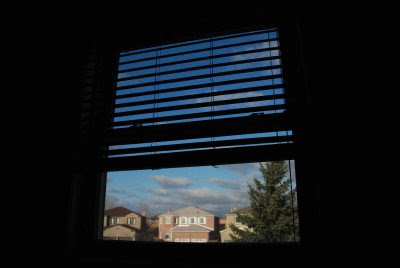
BTW, I did not know how to expose the shot for the outside with the Canon SD110 so I underexposed the shot manually by 2 f-stops to get the blue of the sky. Also, at an equivalent 24mm, the Canon SD110 can shoot at f/2.8 (see the previous post). That is faster than the Nikkor 18-200 f/3.5-5.6 !! :)
As a side note, if you wanted to shoot the window frame with the blue of the sky, underexpose the shot as I have done and turn on flash. In effect, you are exposing for the sky and use the flash to fill in the foreground. This is from the Canon test shots:
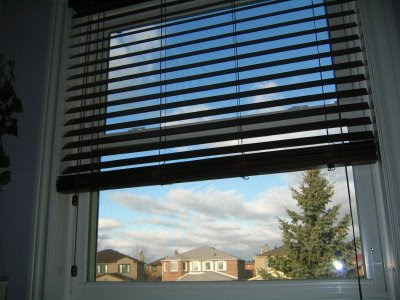
From one place, I shot my window frame. It is clear that the SLR lens at 18mm captures a wider field of view. At the shortest focal length, the 5mm of the tiny lens of the Canon is equivalent to about 24mm or 28mm on an SLR lens.
Canon SD110 at 5mm:

Nikkor 18-200mm at 18mm:

BTW, I did not know how to expose the shot for the outside with the Canon SD110 so I underexposed the shot manually by 2 f-stops to get the blue of the sky. Also, at an equivalent 24mm, the Canon SD110 can shoot at f/2.8 (see the previous post). That is faster than the Nikkor 18-200 f/3.5-5.6 !! :)
As a side note, if you wanted to shoot the window frame with the blue of the sky, underexpose the shot as I have done and turn on flash. In effect, you are exposing for the sky and use the flash to fill in the foreground. This is from the Canon test shots:

Always have a camera on you
 There are days I feel my D80 would be an encumbrance to carry around. On a night into the city for example, I would have more fun if I didn't have to worry about a camera. You should always bring a camera though.
There are days I feel my D80 would be an encumbrance to carry around. On a night into the city for example, I would have more fun if I didn't have to worry about a camera. You should always bring a camera though.Last night, I left my D80 at home and brought my old Canon SD110 along. The SD110 is a neat camera that fits into a small Lowepro pouch. Use it without flash and some results can be surprisingly good -- the truth though is, I never knew how to use it properly in the past until I started playing with the D80. I have always used it the way it was marketed -- point and shoot. The camera will figure out everything for you -- almost everything.
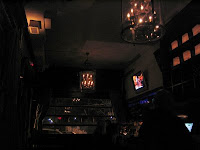 So here were a couple of shots I took. The shot outside the bar was untouched. It was fairly sharp (and this was handheld) and a bit noisy, but it turned out quite colourful. The shot was taken in auto mode at 5mm f/2.8 at 1/8 seconds. ISO was auto -- no idea what was actually used.
So here were a couple of shots I took. The shot outside the bar was untouched. It was fairly sharp (and this was handheld) and a bit noisy, but it turned out quite colourful. The shot was taken in auto mode at 5mm f/2.8 at 1/8 seconds. ISO was auto -- no idea what was actually used.This bar (not the Rhino lounge above) was quite dark. The original shot was darker than what is shown -- I increased the Gamma values and the contrast a bit. I should have overexposed the shot but being that it is a compact camera, its manual settings
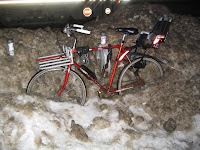 were not as easy to change and so I did not even think of overexposing the shot then. The shot was taken at 5mm f/2.8 at 1/8 seconds. It would appear then this was the limit of the camera. It increased the aperture to the maximum at f/2.8 and the best it can shoot at was 1/8 seconds.
were not as easy to change and so I did not even think of overexposing the shot then. The shot was taken at 5mm f/2.8 at 1/8 seconds. It would appear then this was the limit of the camera. It increased the aperture to the maximum at f/2.8 and the best it can shoot at was 1/8 seconds.The bike shot, well, is a little washed out. It had to be taken with flash, but the point was, I would not have been able to capture anything had I left both cameras home. That bike didn't need a chain. It was entombed in snow and ice!
Saturday, December 27, 2008
Sigma 24-70mm f/2.8 MACRO mode, part 3
Well, I have decided that this Sigma is good but it must go. I think my shooting skills need some tweaking. As of now, I still need VR for handheld photography. I will likely put the money towards a good Nikkor f/2.8 VR lens which might give me an equivalent of an f/1, but this is a tricky business. I like the range I get from my 18-200mm and there is f/2.8 equivalent so if I get any f/2.8, it would be a compromise. There is no more candid shots. It would be for a more for indoor shooting and that is that.
Thursday, December 25, 2008
Formatting your SDHC card
Well well well ... this is interesting. As part of the firmware upgrade, I reformatted the HP 8GB SDHC card using Windows XP before putting the firmware images on. After the second image has been loaded into the camera, I left the SDHC card as it was, formatted with Windows XP.
I was doing some test shooting today when I noticed some difference. It would take a new picture a few seconds to be saved to the card. It also takes a few seconds to delete a picture. Did I notice this behaviour before with this HP SDHC? No, I do not remember seeing this behaviour ever before. Maybe the firmware did something funny to the file I/O subsystem of the camera. I then decided to reformat the SDHC using the built-in camera formatting feature. As it turned out, it was not the SDHC. It has something to do with the way the card was formatted. After the card has been reformatted with the camera's formatting software, saving and delete pictures from the card was quick. Either way, the filesystem format is FAT32. I don't have one of the cool Norton Utilities to inspect the SDHC card but there is some difference between the way the D80 formats a card and the way Windows XP does it. In Windows XP, I performed a "Quick Format" but that is probably what the D80 does anyways as it takes no time to format the SDHC card.
Strange.
Merry Xmas!
I was doing some test shooting today when I noticed some difference. It would take a new picture a few seconds to be saved to the card. It also takes a few seconds to delete a picture. Did I notice this behaviour before with this HP SDHC? No, I do not remember seeing this behaviour ever before. Maybe the firmware did something funny to the file I/O subsystem of the camera. I then decided to reformat the SDHC using the built-in camera formatting feature. As it turned out, it was not the SDHC. It has something to do with the way the card was formatted. After the card has been reformatted with the camera's formatting software, saving and delete pictures from the card was quick. Either way, the filesystem format is FAT32. I don't have one of the cool Norton Utilities to inspect the SDHC card but there is some difference between the way the D80 formats a card and the way Windows XP does it. In Windows XP, I performed a "Quick Format" but that is probably what the D80 does anyways as it takes no time to format the SDHC card.
Strange.
Merry Xmas!
Batteries, once again
A while ago, I wrote about third-party batteries. I mentioned how unreliable third-party batteries have been. In particular, an EN-EL3e battery I bought worked for only a few rechargeable cycles. What a waste of money. In photography, you get what you pay for. That statement is very true but I wonder if I had not given those batteries their proper dues.
I just found out that Nikon released a new firmware for the D80. I had the original firmware 1.01 on. The latest firmware, version 1.11, was supposed to fix a problem with the battery indicator (see below). I wonder now if my battery problem had not been related to this bug, where even though the third-party battery was full, the D80 thought the battery was drained. My conclusion at the time was, faulty battery. I am not so sure after seeing this firmware update. So, I will recant for now as it might just be a firmware bug. Well, my D80's firmware is up-to-date now. It is unfortunately I cannot test that third-party battery anymore as I had completely dissected it already.
From Nikon's description of the firmware update:
I just found out that Nikon released a new firmware for the D80. I had the original firmware 1.01 on. The latest firmware, version 1.11, was supposed to fix a problem with the battery indicator (see below). I wonder now if my battery problem had not been related to this bug, where even though the third-party battery was full, the D80 thought the battery was drained. My conclusion at the time was, faulty battery. I am not so sure after seeing this firmware update. So, I will recant for now as it might just be a firmware bug. Well, my D80's firmware is up-to-date now. It is unfortunately I cannot test that third-party battery anymore as I had completely dissected it already.
From Nikon's description of the firmware update:
Modifications enabled with upgrade of A and B firmware to 1.11
- An issue that, in some rare circumstances, caused the battery indicator to blink, regardless of actual battery charge, has been resolved.
Monday, December 22, 2008
SDHC speed
Here is a non-scientific test of my SD/SDHC cards. The test was, to write 70MB of a Java folder from the C: drive to the root folder of a memory card connected to a USB2.0 port, disconnect the memory card, reconnect the card, then transfer the Java folder from the memory card back to a temporary folder on the C: drive.
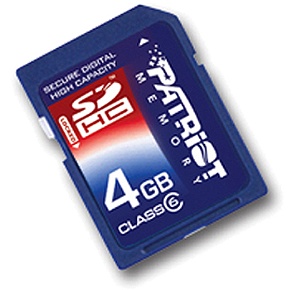 Patriot 4GB SDHC (Class 6)
Patriot 4GB SDHC (Class 6)
Writing to the card: 90 seconds
Reading from the card: 30 seconds
HP 8GB SDHC (Class 4)

Writing to the card: 80 seconds
Reading from the card: 28 seconds
Kingston 2GB SD
Writing to the card: 105 seconds
Reading from the card: 26 seconds
Foto Source 1GB SD
Writing to the card: 75 seconds
Reading from the card: 27 seconds
The fastest overall of the bunch is this Foto Source 1GB SD card bundled with the Nikon D80 when I purchased it. It was not really part of the package but the store just threw it in. It's a no name brand. The new 8GB SDHC comes next, followed by my first SDHC card, the 4GB SDHC, and then the Kingston 2GB SD. The 8GB SDHC is a Class 4 SDHC (this Class specifies a minimum speed of 4x, i.e. 4 x 150 kBps or 600 kBps). It performs better than expected at about 1.1 MBps. The Class 6 Patriot 4GB SDHC card is expected to write at a minimum 900kBps. Well, it writes at over 1.2 MBps.
I thought the Kingston 2GB SD was really fast, from what I could see when viewing pictures off the card but when sustained writes are performed, it does not measure up very well. The specs of it are: up to 5 MBps reads and 1.5 MBps writes. It does not appear to perform anywhere close to specs on sustained I/O. Sustained reads and writes took more than twice longer than expected. Very disappointing.
Regardless of the speed, there is absolutely no problems with using any of these SD or SDHC cards in a D80 for continuous shooting. Remember that the D80 has a internal write buffer.
 Patriot 4GB SDHC (Class 6)
Patriot 4GB SDHC (Class 6)Writing to the card: 90 seconds
Reading from the card: 30 seconds
HP 8GB SDHC (Class 4)

Writing to the card: 80 seconds
Reading from the card: 28 seconds
Kingston 2GB SD
Writing to the card: 105 seconds
Reading from the card: 26 seconds

Foto Source 1GB SD
Writing to the card: 75 seconds
Reading from the card: 27 seconds
The fastest overall of the bunch is this Foto Source 1GB SD card bundled with the Nikon D80 when I purchased it. It was not really part of the package but the store just threw it in. It's a no name brand. The new 8GB SDHC comes next, followed by my first SDHC card, the 4GB SDHC, and then the Kingston 2GB SD. The 8GB SDHC is a Class 4 SDHC (this Class specifies a minimum speed of 4x, i.e. 4 x 150 kBps or 600 kBps). It performs better than expected at about 1.1 MBps. The Class 6 Patriot 4GB SDHC card is expected to write at a minimum 900kBps. Well, it writes at over 1.2 MBps.
I thought the Kingston 2GB SD was really fast, from what I could see when viewing pictures off the card but when sustained writes are performed, it does not measure up very well. The specs of it are: up to 5 MBps reads and 1.5 MBps writes. It does not appear to perform anywhere close to specs on sustained I/O. Sustained reads and writes took more than twice longer than expected. Very disappointing.
Regardless of the speed, there is absolutely no problems with using any of these SD or SDHC cards in a D80 for continuous shooting. Remember that the D80 has a internal write buffer.
Sunday, December 21, 2008
Nikkor 18-200mm in the Cloud Forest
Below are a couple of pictures John shot with his D70s and my Nikkor 18-200mm in the Cloud Forest of Santa Elena. They came out quite sharp. The first was shot at 200mm f/5.6 ISO400 for 1/20 seconds. The second was shot at 18mm f/3.5 ISO400 for 1/80 seconds.
A juvenile centipede crawling on the forest floor:

A full 1:1 crop of the centipede:
 Me among the trees -- John has a good eye for composition and perspectives, and it helps that a lens can do 18mm:
Me among the trees -- John has a good eye for composition and perspectives, and it helps that a lens can do 18mm:
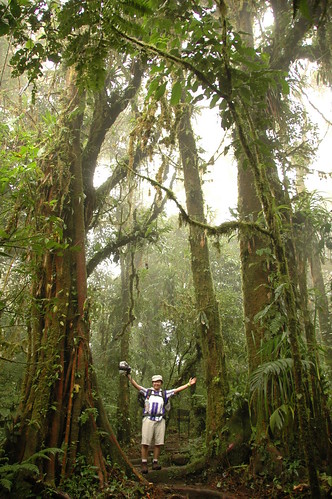
A juvenile centipede crawling on the forest floor:

A full 1:1 crop of the centipede:
 Me among the trees -- John has a good eye for composition and perspectives, and it helps that a lens can do 18mm:
Me among the trees -- John has a good eye for composition and perspectives, and it helps that a lens can do 18mm:
Sigma 24-70mm f/2.8 MACRO mode, part 2
 Here are a couple of pictures I took with the extension tube behind the Sigma lens.
Here are a couple of pictures I took with the extension tube behind the Sigma lens.I cannot get the "Unlock Computer" screen up anymore than I cannot measure the actual optical field of view width.
The pen tip however is measurable. The upper left corner of the image to the tip of the pen is about 1.1 cm long. The diameter of the field of view is about 1.8 cm, definitely less than 2 cm long. The width of the optical field of view is thus about 1.5 cm. The sensor of the D80 is 2.36cm wide so this is absolutely better than 1:1 magnification!
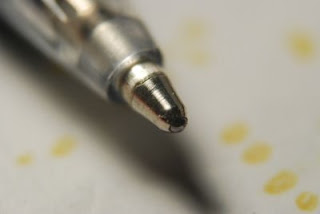
What I learned from Costa Rica, part 4
This is about traveling with a tripod.
How do you carry your tripod around? Inside your backpack or outside? One way or another, your tripod would have to be stored inside some luggage bag for the flight because it may not be allowed to be carried as a carry-on on the plane. When you get to your destination though, how should you carry it?
In Costa Rica, I read that theft levels are on the increase. It made me uneasy to carry any camera gears on the outside of my backpack. You are just drawing attention to yourself. If they see a tripod, they might think you have more valuables on the inside of the backpack. So, my tripod was stuffed in my 60L backpack, away from prying eyes, most of the time.
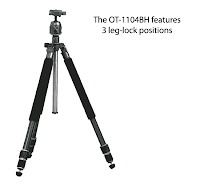 Fully compressed and disassembled (the vertical column can be removed), my OPUS OT-1104BH tripod can fit in virtually any backpack. It's quite small. However, I thought it would be easier to keep the vertical column and the ball head on at all time so I can draw the tripod out of the backpack and use it instantly. My backpack contains my clothes though. It might be easy to draw the tripod out but to re-insert it back into the backpack would be challenging. My solution was to use the box the tripod came in. The box felt bulky but it works really well. The rigid structure of the box reserves space in my backpack so the tripod can easily go in and out of the box whenever I need it.
Fully compressed and disassembled (the vertical column can be removed), my OPUS OT-1104BH tripod can fit in virtually any backpack. It's quite small. However, I thought it would be easier to keep the vertical column and the ball head on at all time so I can draw the tripod out of the backpack and use it instantly. My backpack contains my clothes though. It might be easy to draw the tripod out but to re-insert it back into the backpack would be challenging. My solution was to use the box the tripod came in. The box felt bulky but it works really well. The rigid structure of the box reserves space in my backpack so the tripod can easily go in and out of the box whenever I need it.
Two caveats of using the box are: it does take up probably twice as much space as the tripod itself and the double layer of cardboard materials add on more weight. However, the box keeps my clothes and everything else inside the backpack clean and dry from the dirt and sometimes water on the tripod.
How do you carry your tripod around? Inside your backpack or outside? One way or another, your tripod would have to be stored inside some luggage bag for the flight because it may not be allowed to be carried as a carry-on on the plane. When you get to your destination though, how should you carry it?
In Costa Rica, I read that theft levels are on the increase. It made me uneasy to carry any camera gears on the outside of my backpack. You are just drawing attention to yourself. If they see a tripod, they might think you have more valuables on the inside of the backpack. So, my tripod was stuffed in my 60L backpack, away from prying eyes, most of the time.
 Fully compressed and disassembled (the vertical column can be removed), my OPUS OT-1104BH tripod can fit in virtually any backpack. It's quite small. However, I thought it would be easier to keep the vertical column and the ball head on at all time so I can draw the tripod out of the backpack and use it instantly. My backpack contains my clothes though. It might be easy to draw the tripod out but to re-insert it back into the backpack would be challenging. My solution was to use the box the tripod came in. The box felt bulky but it works really well. The rigid structure of the box reserves space in my backpack so the tripod can easily go in and out of the box whenever I need it.
Fully compressed and disassembled (the vertical column can be removed), my OPUS OT-1104BH tripod can fit in virtually any backpack. It's quite small. However, I thought it would be easier to keep the vertical column and the ball head on at all time so I can draw the tripod out of the backpack and use it instantly. My backpack contains my clothes though. It might be easy to draw the tripod out but to re-insert it back into the backpack would be challenging. My solution was to use the box the tripod came in. The box felt bulky but it works really well. The rigid structure of the box reserves space in my backpack so the tripod can easily go in and out of the box whenever I need it.Two caveats of using the box are: it does take up probably twice as much space as the tripod itself and the double layer of cardboard materials add on more weight. However, the box keeps my clothes and everything else inside the backpack clean and dry from the dirt and sometimes water on the tripod.
How much memory is enough?
I just received an 8GB SDHC card. I was not sure if it would work with the D80. Well, it does! In addition to the current set of cards I have, I now have 17GB of SD/SDHC cards for my camera. I think I will start to record in both high-resolution JPEG and RAW formats. I have spent up a full 8GB over three cards on one vacation trip before so having an additional 8GB will make me even more generous in my shooting. Having said that, I do recognize the need to be more selective and take time to compose my pictures. So, I have 17GB of memory. My friends will not like this.
Sunday, December 14, 2008
Sigma 24-70mm f/2.8 MACRO mode
The Sigma's Macro mode is ok. A real-life ratio of 1:3.8 is not bad, but remember I still have my extension tube? It was used with both the Nikkor 50mm f/1.8 and the Vivitar 70-210mm f/3.5 for macro. The results were good. Well, I decided to run a quick test with the Sigma.
I will post the images later but I could easily magnify better than real-life ratio of 1:1. It sounds really good but the lens has to get really close to the subject, and then light becomes a big issue. My hotshoe speedlight alone might not be tall enough to hit the subject, especially when this lens is 82mm on the far end. I will have to use it as a remote or get some reflectors set up.
I will post the images later but I could easily magnify better than real-life ratio of 1:1. It sounds really good but the lens has to get really close to the subject, and then light becomes a big issue. My hotshoe speedlight alone might not be tall enough to hit the subject, especially when this lens is 82mm on the far end. I will have to use it as a remote or get some reflectors set up.
Friday, December 12, 2008
DSLR recommendation
A friend asked me about buying the Nikon D90. I thought I'd share my view with everyone else here. Here was the e-mail I sent:
I want to buy the D700 but it is $3000, too expensive for my needs.
The D90 would come next. I like its higher ISO performance and image processing.
On a typical day when you take the camera around, indoors and outdoors, I want to be able to shoot without flash. The higher ISO performance would be very welcoming. Compared to my D80, the D90 can shoot twice as fast and still deliver the same image quality. Having said that, sometimes, you have no choice but to use flash, to enhance light conditions and for artistic effects.
Many people will tell you the camera body is not the most important component of the camera system. True, but if the camera can capture better images for the non-professionals (e.g. better auto exposure, cleaner images, more shooting options), the better.
After you pick a camera, the next big question is what lens to use. The answer depends on how and what you want to shoot. For me, I have done:
1) A few macro photography
2) Lots of candid camera shots (need a zoom lens for this)
3) Lots of nature (not birds) shots
4) Few bird shots
5) Few portrait shots
6) Lots of baby / toddlers shots
7) Very few action shots (need a fast, big zoom lens)
Some photographers have a dedicated lens for every situation. Dedicated lens means highest quality for a specific condition. We cannot afford to do the same so I look for a good walkaround zoom lens that will cover a bit of the macro, all of the candid/nature shots, most of the portrait shots, and some of the baby shots. At the same time, I look for a lens that will give me the sharpest picture.
My walkaround Nikkor 18-200mm lens is *ok*. Not the best, even at $950 when I bought it almost two years ago; it is only $650 now. Another option is the Sigma 18-200mm. It is a tad bit slower than the Nikkor but outdoors, there is no difference. Indoors, you will appreciate the 1 extra f-stop the Nikkor gives.
After shooting with the Nikkor 18-200mm for almost two years, I find that I do use all of the range, 18mm all the way to 200mm. What you want to shoot will define the focal range you want:
Portrait: 50-70mm
Landscape: 18mm and lower (as wide as possible)
Family: 18mm-50mm
Birds: 400mm+
Candid: 18-300mm (yeah, 300mm would be great)
Sports: 70-400mm
When looking for a lens, look for one with Vibration Reduction II technology (VR) -- Canon calls it Image Stabilization (IS) and others call it differently yet. It helps with *handheld* shots tremendously. Also, the longer the focal length, the slower the lens becomes -- unless you buy a fixed aperture lens (extremely expensive).
I want to buy the D700 but it is $3000, too expensive for my needs.
The D90 would come next. I like its higher ISO performance and image processing.
On a typical day when you take the camera around, indoors and outdoors, I want to be able to shoot without flash. The higher ISO performance would be very welcoming. Compared to my D80, the D90 can shoot twice as fast and still deliver the same image quality. Having said that, sometimes, you have no choice but to use flash, to enhance light conditions and for artistic effects.
Many people will tell you the camera body is not the most important component of the camera system. True, but if the camera can capture better images for the non-professionals (e.g. better auto exposure, cleaner images, more shooting options), the better.
After you pick a camera, the next big question is what lens to use. The answer depends on how and what you want to shoot. For me, I have done:
1) A few macro photography
2) Lots of candid camera shots (need a zoom lens for this)
3) Lots of nature (not birds) shots
4) Few bird shots
5) Few portrait shots
6) Lots of baby / toddlers shots
7) Very few action shots (need a fast, big zoom lens)
Some photographers have a dedicated lens for every situation. Dedicated lens means highest quality for a specific condition. We cannot afford to do the same so I look for a good walkaround zoom lens that will cover a bit of the macro, all of the candid/nature shots, most of the portrait shots, and some of the baby shots. At the same time, I look for a lens that will give me the sharpest picture.
My walkaround Nikkor 18-200mm lens is *ok*. Not the best, even at $950 when I bought it almost two years ago; it is only $650 now. Another option is the Sigma 18-200mm. It is a tad bit slower than the Nikkor but outdoors, there is no difference. Indoors, you will appreciate the 1 extra f-stop the Nikkor gives.
After shooting with the Nikkor 18-200mm for almost two years, I find that I do use all of the range, 18mm all the way to 200mm. What you want to shoot will define the focal range you want:
Portrait: 50-70mm
Landscape: 18mm and lower (as wide as possible)
Family: 18mm-50mm
Birds: 400mm+
Candid: 18-300mm (yeah, 300mm would be great)
Sports: 70-400mm
When looking for a lens, look for one with Vibration Reduction II technology (VR) -- Canon calls it Image Stabilization (IS) and others call it differently yet. It helps with *handheld* shots tremendously. Also, the longer the focal length, the slower the lens becomes -- unless you buy a fixed aperture lens (extremely expensive).
Saturday, December 6, 2008
How reliable is my NAS ?
If you remembered, I built a RAID5 NAS using Slackware Linux 9 to store my photos online at home. I use JAlbum now to create online albums with resampled photos, but the original images stay on my NAS.
Today, I wanted to expand the storage. I had initially allocated 300GB to the logical volume. I have used over 50% of the storage volume already and before I dump anymore on it, I thought I'd expand the volume.
First some background: I have 4 x 320GB SATA drives. I use software RAID to create a RAID-5 partition and used Linux's Logical Volume Manager (LVM) to manage my volumes within the partition. I use the ext3 filesystem to store my files.
To expand the ext3 filesystem, there are three steps:
On to resize2fs. This command is a bit of a memory hog too. It was running for a while from the console until it gobbled up all memory and caused the kernel to panic and hang. Well, that could not be good. Here I had 150GB worth of files and was I about to lose all of it?
I knew I had more RAM somewhere at home so I went to an old machine and yanked out a bar of RAM. With an additional 256MB, my NAS was restarted. I re-executed resize2fs. It took its time ... did not crash ... it took more time ... still not crashing. The signs were good. It completed without any errors. It expanded the 300GB volume to about 600GB.
The ext3 filesystem has shown to me to be quite resilient to operational failure.
Today, I wanted to expand the storage. I had initially allocated 300GB to the logical volume. I have used over 50% of the storage volume already and before I dump anymore on it, I thought I'd expand the volume.
First some background: I have 4 x 320GB SATA drives. I use software RAID to create a RAID-5 partition and used Linux's Logical Volume Manager (LVM) to manage my volumes within the partition. I use the ext3 filesystem to store my files.
To expand the ext3 filesystem, there are three steps:
- Make sure you have space in the RAID Volume Group (VG).
- Use lvextend to extend the logical volume to whatever size that is available from the VG.
- Use resize2fs to resize the ext3 filesystem.
On to resize2fs. This command is a bit of a memory hog too. It was running for a while from the console until it gobbled up all memory and caused the kernel to panic and hang. Well, that could not be good. Here I had 150GB worth of files and was I about to lose all of it?
I knew I had more RAM somewhere at home so I went to an old machine and yanked out a bar of RAM. With an additional 256MB, my NAS was restarted. I re-executed resize2fs. It took its time ... did not crash ... it took more time ... still not crashing. The signs were good. It completed without any errors. It expanded the 300GB volume to about 600GB.
The ext3 filesystem has shown to me to be quite resilient to operational failure.
Subscribe to:
Posts (Atom)
Invasion of What?
What are these bugs? I've never seen them before. I saw them at my parents' place the other day. Lots of them in soil or grassy areas.

-
What are these bugs? I've never seen them before. I saw them at my parents' place the other day. Lots of them in soil or grassy areas.
-
This shot was taken with the D7200 from inside my car. I had to pull over quickly and I didn't have time to think about the settings. I ...
-
A local Zellers store is having liquidation sales of everything in the store. I was browsing through some electronics the other day--not pl...

